Dec 24, 2025
Dec 24, 2025
A Glorious Civilization Lost to Religious Persecution
Continued from Previous Page
The Persian civilization is among one of the most glorious civilizations of the bygone world history. At its peak, it was one of the most developed and progressive civilizations and sort of the first superpower in the Western world. This civilization was also unique from the point of view that the Persian prophet Zoroaster had successfully introduced religious reforms from polytheism to monotheism much before the advent of Jesus Christ; and in due course, the Zoroastrianism served as a paradigm and precursor religion for the later Abrahamic religions like Judaism, Christianity and Islam in the West. Sadly, the Persian people were also the ones who had to bear most the brunt of fanaticism in the form of religious persecution that nearly wiped out Zoroastrians from Persia (now Iran) with only those few surviving who were able to leave their motherland and home secretly under the cover of darkness.
History of Persia
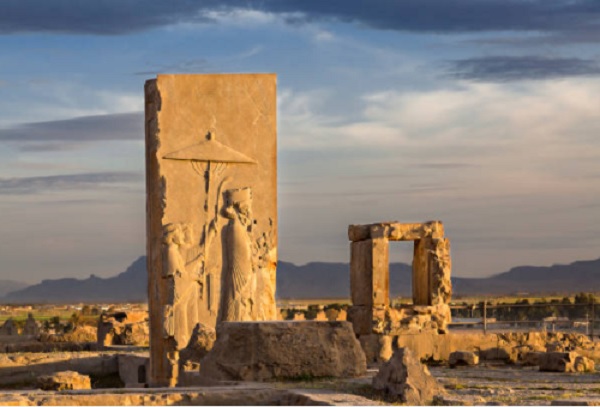
Remains of ancient Persepolis in Iran
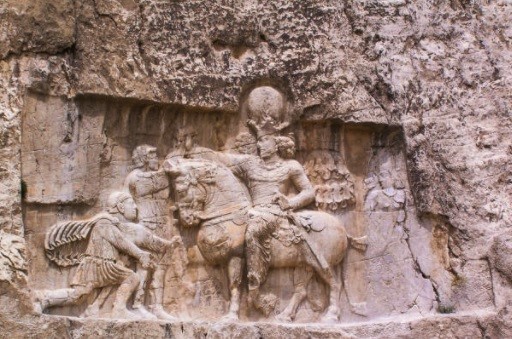
Rock carvings in the necropolis of Naqsh-e Rustam near the ancient ruined city of Persepolis, Iran.
The earliest traces of human inhabitation in Persian land had been found as the archaeological artifacts comprising of Mousterian stone tools in the Kashafrud and Ganj Par sites which are considered to be more than ten thousand years during the Paleolithic period. Similarly, the early settled dwellers of the agricultural communities such as Chogha Golan and Chogha Bonut are believed to have flourished in and around the Zagros Mountains region in western Persia as back as eight to ten thousand BCE. The earliest-known artefacts suggesting organized human settlers based on carbon dating technique are the findings of clay vessels, jars of wine and modelled human and animal terracotta figurines in these areas. Possibly, the south-western part of Persia was the Fertile Crescent where most of the Persian people raised their major crops with few identified settlements at locations such as Chogha Mish (6800 BCE) and Susa (4395 BCE).
During the Bronze Age, the Kura–Araxes culture of Persian people (3400 - 2000 BCE) flourished in the parts of Persia what is called the modern-day northwestern Iran, which stretched right upto the neighbouring regions of the Caucasus and Anatolia. The name of the aforesaid culture is derived from the Kura and Araxes river valleys. The Caucasus region represented the area between the Black Sea and the Caspian Sea while the Anatolia, also known as Asia Minor, is a large peninsula in Western Asia and the westernmost protrusion of the Asian continent, largely representing the modern-day Turkey. Archaeological records suggest the existence of several lesser-known ancient groups and urban settlements during the fourth and third millennia BCE, and one such rather prominent one being the Jiroft culture in southeastern Persia province of Kerman. Elam was another prominent ancient culture in the far west and southwest of Persia, and archaeologists have recovered a variety of objects decorated with distinctive engravings of animals, mythological creatures and architectural motifs at these sites.
Around 2000 BCE and through the Iron Age, with the rise of the Neo-Assyrian Empire, apparently more and more tribes from the Pontic–Caspian steppe and other areas made incursions in the Persian land. Their arrival and aggressive maneuvers forced the Elamites to retreat and relinquish their areas to take refuge in Elam, Khuzestan and other nearby areas. According to Western historians, mostly people of Persian, Mede and Parthian origin populated the Persian land by the mid-first millennium BCE. During this period, the Assyrian civilization was on rise and the Assyrian king ravaged through Susa in 646 BCE ending Elamite dominance in the region. Persia remained under the constant threat from Assyrians for over a century that compelled the small kingdoms of the western Persian plateau to coalesce to form larger and more centralized states.
The period of the Median and Achaemenid Empire (650 – 330 BCE) was more pronounced and powerful in the Persian history. Persians were constantly troubled by the Assyrians for several decades; however, combined forces of Deioces’s grandson Cyaxares and Babylonian king Nabopolassar later invaded Assyria and convincingly defeated them leading to fall of the Neo-Assyrian Empire. Ordinarily, the Medes are given credit for founding Persia as a nation and empire, till finally Cyrus the Great (559 – 530 BCE) established a unified empire of the Medes and Persians, which was later known as the Achaemenid Empire (550 – 330 BCE) in the Persian history. He was one who subjugated the Median, Lydian and Neo-Babylonian Empires, thereby himself creating an empire greater than Assyria. Cyrus is also considered an able ruler and warrior who followed somewhat benign policies to take along his subjects as a popular king.
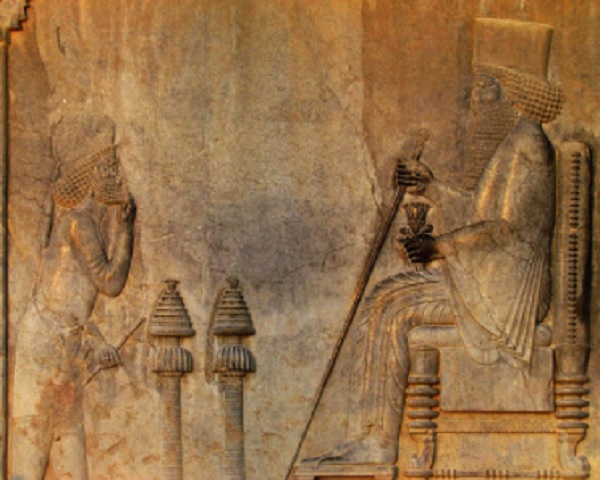
Details of a relief on the stairs of the ruins of the Apadana Palace at Persepolis. Persepolis is situated 70 km northeast of Shiraz, Iran, and was the capital of the Achaemenid Empire (550-330 BC).
Darius I, also known as Darius the Great, was third Persian King of the Achaemenid Empire, reigning from 522 BCE until his death in 486 BCE. He is not only remembered for expansion of the empire through constant military campaign including Egypt and Greece but also for introducing many reforms. For instance, he built a canal between the Nile and the Red Sea, which is considered a forerunner of the modern Suez Canal and standardized the coinage system. Under the two great kings, Cyrus the Great and Darius I, the Persian Empire became the largest empire in human history until that date. His successor Xerxes had prolonged wars with Greeks, in which initially Persia succeeded in consolidating their position by nearly occupying half of the Greek territories but later Greeks had repeated victories and Persians lost control over Macedonia, Thrace and Ionia. The decades of war between the Achaemenid empire and combined Greek city-states under Delian League eventually ended in a truce in 449 BCE.
However, Gecko-Persian rivalry for supremacy continued and Greeks invaded Persia again under Alexander the Great, who defeated Persian King Darius III and conquered the Persian Empire by 331 BCE. Although Alexander did not live long to rule but his general Seleucus Nicator established his own empire to reign Persia, Mesopotamia and other territories in the region.
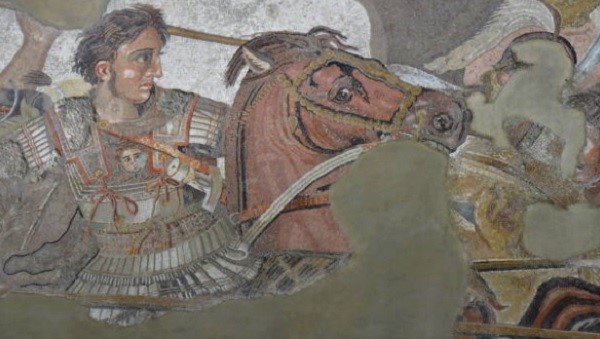
Alexander the Great vs Darius
Though Seleucus was assassinated by Ptolemy Keraunos in 282 BCE, his Seleucid Empire lasted for three more decades till 248 BCE through his inheritors. The Seleucid empire was replaced by Parthian Empire, comprised of people of Persian origin only from the northwestern Persia, who had reunited to overthrow Seleucids of the Greek origin.
Parthian Empire lasted nearly for five centuries till 224 CE. During this period, they intermittently controlled Mesopotamia and parts of the eastern Arabia. This period was remarkable for the Parthians’ continued feud and wars with the arch-rivals and enemy Roman Empire, in which the former kept the latter in check largely due to own superior cavalry. While the Romans largely depended on the heavy infantry, the Parthians engaged two types of cavalry; one, the heavily armed and armoured cataphracts, and two, the lightly-armed yet highly-mobile mounted archers. Though they remained invincible to Romans but the end of Parthian Empire came at the hands of their own vassal people, the Persians under the Sasanians in 224 CE.
Persia under the Sasanian Empire (224 - 651 AD) regained its lost civilizational glory and flourished well with their contemporary Roman and Byzantine Empires. The first Shah Ardashir I of the Sasanian empire introduced many economic and military reforms. At its peak, the empire encompassed and influenced nearly all of the modern Iran, Iraq, Azerbaijan, Armenia, Georgia, Republics of Abkhazia and Dagestan, Lebanon, Jordan, Palestine, Israel, parts of Afghanistan, Turkey, Syria, parts of Pakistan, Central Asia, Eastern Arabia, and parts of Egypt. The period was also remarkable for the sustained Persian-Roman wars and many Persian conquests. The Sassanians preferred to call their empire Eranshahr (i.e., Dominion of Aryans) and their period was one of the most important and influential span of the Persian and world history.
Ironically, apart from the glorious peak, the Sassanian period also turned out a doom for the ancient Persian civilization. While the Sassanian Shah Yazdegerd III ruled over the Persia, Umar led Muslims invaded the country in 633 CE when the empire was already in a mess due to civil war following the mutiny by some noble families and military generals. The Persian Shah Yazdegerd could not survive double whammy of Arabs onslaught and inhouse mutinies; he fled from place to place and was finally assassinated by a local miller in 651 CE. Arab Muslims had conquered Greater Khorasan by 674 CE and more territories in the following years. The Muslim conquest of Persia marked the end of the Sassanian Empire and subsequent systematic Islamic persecution ensured the eventual decline and end of the Zoroastrian religion in Persia. Over a period, the most of Persian people were either converted to Islam or killed as kaffirs. According to the Qissa-i Sanjan, few Persians (Zoroastrians) were able to migrate to the Indian coastal state of Gujarat, where they were given asylum between the 8th to 10th centuries CE to escape persecution from the Muslim tyranny.
Persian Pantheon and Zoroastrianism
Prior to the rise of Zoroastrianism in Persia, the ancient Persian religion was a polytheistic faith with a pantheon led by the supreme god Ahura Mazda (Lord of Wisdom). He was considered as champion of order against the dark forces led by Angra Mainyu (Destructive Spirit) and his legions of chaos. This position was somewhat akin to all other contemporary religions of the world with polytheistic faith, wherein each god had their own field of expertise over which they presided and common people or devotees would pray them as per their specific problems and needs.
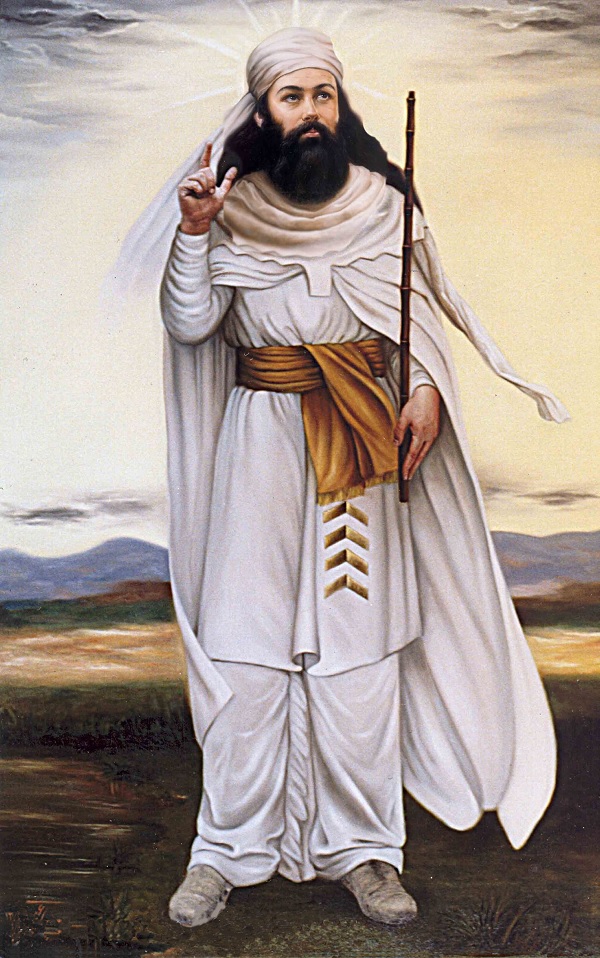
Zoroaster was an ancient Persian prophet who founded what is now known as Zoroastrianism based on the monotheistic order. His sermons challenged the existing Persian pantheon based on numerous deities and his articulated teachings were forceful enough to usher in a movement followed by the contemporary Persian masses. Ultimately, Zoroastrianism became the dominant religion of the ancient Persia which was formally adopted too. There is no scholarly consensus about his birthplace, or when and where he lived. However, the common belief is that he was a native speaker of Old Avestan, who lived in the eastern part of the Persian Plateau. Some scholars suggest a period somewhere between 1500 – 1000 BCE citing linguistic and socio-cultural evidence while others believe that he actually lived in the seventh and sixth century BCE.
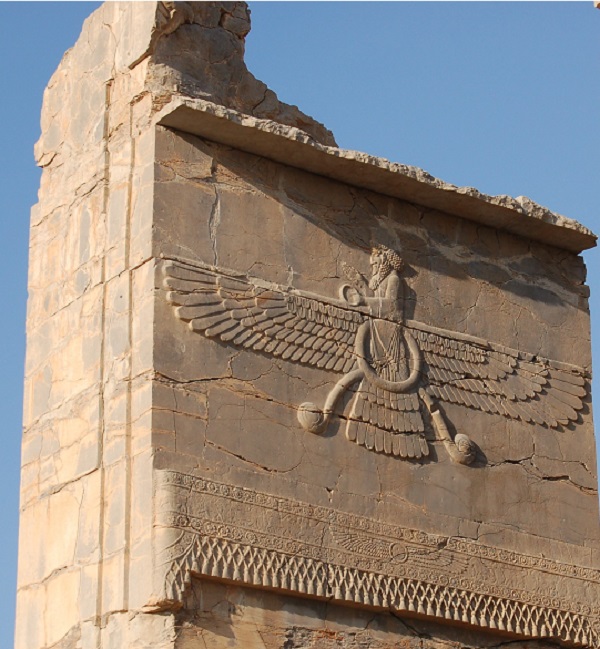
Zoroastrianism became the official religion of Ancient Persia most probably between the seventh and sixth century BCE. Zoroaster had conceived of a new concept in which one Supreme Deity, Ahura Mazda could take care of all human problems and needs. He insisted that it was always like this and people mistakenly believed that there were many gods. As Zoroaster's concept had greater acceptance, the worship of multiple deities in the pantheon reduced and became centric to “Ahura Mazda”. People were still occasionally praying such figures as goddess Anahita for conception but treating her only as an aspect of Ahura Mazda. Zoroastrianism had a dualistic cosmology of good and evil, and apart from monotheism, it had other ingrained elements of messianism, judgment after death, heaven and hell, and free will, which probably heavily influenced other contemporary and futuristic religions such as Judaism, Christianity and Islam.
To sum up the ingrained principles of Zoroastrianism, monotheism is the belief in only one god that created the world, and is omnipotent, omnipresent and omniscient. Although the Western historians and Abrahamic religions often boast about this being unique and eternal, the Vedas and Upanishads of Hinduism which are undoubtedly of older origin have always held “Brahman” as the Supreme Truth of the universe with the similar and many more universal attributes, Who is responsible for all creation, sustenance and withdrawal and various deities only being His aspects/manifested forms. Messianism is the belief in a prophet or messiah who acts as the savior or liberator of people and that is what Zoroaster was himself. Judgment and afterlife with the commensurate reward or punishment has been a central theme in various religions, only methodologies differ, and so is the concept of heaven and hell. Free will implies to the concepts of moral responsibility, praise, guilt, sin, other crucial actions, and so on that are freely chosen by the followers. Zoroastrianism is believed to have served as the state religion of Persia for about a millennium and declined from the 7th century AD onwards following the Muslim conquest of Persia and subsequent persecution of Zoroatrians.
Persecution of Zoroastrians is a dark phase of the Persian history which started with the Muslim invasion and conquest of Persia. The religious persecution was inflicted upon the followers of the Zoroastrian faith initially as sparse violence and forced conversions. Gradually, the places of Zoroastrian worship were desecrated, the fire temples of the faith were systematically destroyed and replaced by mosques, and people were forced to pay the jizya tax. Libraries of Zoroastrian literature and faith were identified and burned to destroy cultural legacies and knowledge bank. Further, widespread discriminatory laws were increasingly forced regulating and limiting Zoroastrian conduct and participation in society. Such measures and increasing violence against the community led to significant decrease in the number of Zoroastrians. Most of them were either forced to convert or killed, a small number of them managed to leave Persia by sea route and survived in India as Parsis community.
Persian Gods and Goddesses
Ancient Persian people, before the advent of Zoroastrianism, believed and worshipped a large number of prominent as well as lesser gods and goddesses like other contemporary civilizations in the world. This polytheistic pantheon was, however, centred around the supreme god Ahura Mazda (Lord of Wisdom) and his associate gods, and Angra Mainyu (Destructive Spirit) and his legions of chaos representing the dark forces. Each such god or goddess had their area of specialization and people worshipped them accordingly. Twelve of these more prominent deities were also retained in the new order with Ahura Mazda as the Supreme God of Zoroastrianism and Angra Mainyu as his chief opponent. These gods and goddesses continued to be worshipped as powerful aspects of Ahura Mazda, are briefly described here.
1. Ahura Mazda
Ahura Mazda is the creator and principal deity of the Persian pantheon and Zoroastrians and is remembered with several names such as Ohrmazd, Oromasdes, Ahuramazda, Hormazd and Hurmuz. He is the creator and highest deity of Zoroastrianism. He was the first and formost worshipped god and in later period he was often invoked in a triad with god Mithra and goddess Anahita during yasna, which is an Avestan nomenclature of the main act of worship. The literal meanings of the terms Ahura is "lord," and Mazda is "wisdom", accordingly, he is considered the king of gods. He is believed to have created everything including sky, water and earth, all creatures, and covered earth with plants and flowers in the same order.
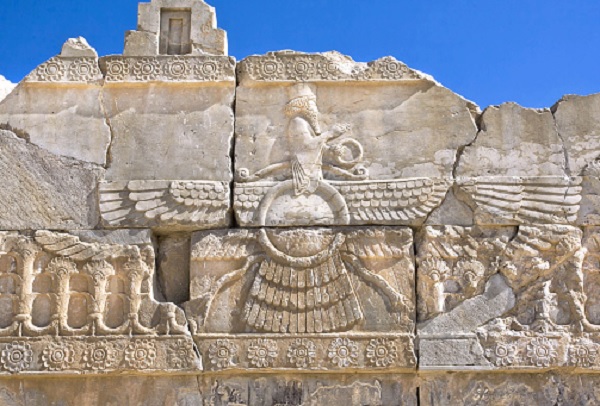
According to ancient Persian belief, Ahura Mazda first created the Primordial Bull Gavaevodata which was so beautiful and unique that it immediately created the attention of the evil god Angra Mainyu who killed the bull. Then Ahura Mazda purified the body of bull on the moon and from its purified seed, he created all animals and first human prototype Gayomoartan, who was again killed by Angra Mainyu. This time from Gayomoartan’s purified seed, the god created the first mortal couple – Mashya and Mashyanag – who lived a blissful life till the evil Angra Mainyu's lies corrupted them. Consequently, the couple lost the paradise but descendant human species was granted “free will” by Ahura Mazda to enable them to chose for self if they wanted to follow good or evil. In ancient Persia, kings were known to have an empty chariot drawn by white horses in the army, which was symbolic to inviting the principal god to accompany the army on battles.
2. Angra Mainyu
Angra Mainyu has remained the god of Evil, Chaos and Discord as the principal rival and challenger to the king of gods, Ahura Mazda and/or the Spenta Mainyu, which is a group of seven divinities in Zoroastrianism emanating from Ahura Mazda. He is believed to unleash the legions of dark spirits known as the daevas with the sole objective of disrupting the world order created by Ahura Mazda by destroying everything which is good and beautiful. According to the Western scholars and historians, he does not find a mention in the early Persian pantheon and was probably highlighted after Zoroastrianism came in existence. Apparently, he was also a creation of Ahura Mazda like other emanations but turned hostile and malevolent towards the creation. In a derivative belief system, Zurvanism or Zorvanism, the god Akarana Zorvan was the primordial creator god and Ahura Mazda and Angra Mainyu were twin brothers born out of him with equal status and powers.
3. Mithra
Mithra or Mehr was the god of the rising sun, covenants, contracts and kingship in the early Persian pantheon and laterin the Zoroatrianism as well. Besides he was also considered the protector of truth, and the guardian of cattle, harvest and waters. As the most powerful and effective warrior against the dark forces, he is depicted as riding the chariot drawn by the white horses and armed with a silver spear, golden bow and arrows, daggers, axes, and also a mace as his most formidable weaponry. In early pantheon, he was also a deity of the cosmic order and systematic change of the seasons. He was often linked with the haoma plant as an usherer of the enlightenment. The common belief was that a king gets the right to rule with the blessings of the god Mithra and if the former violates his righteous duties, the divine grace of the latter is withdrawn to find another worthy successor.
4. Anahita
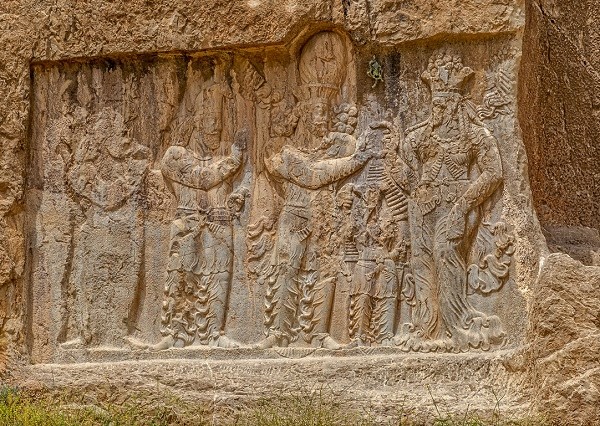
Ancient relief of the necropolis Naqsh-e Rustam that shows the ordination of Narseh by goddess Anahita, Iran, Sasanian civilization 4th century AD.
Ardvi Sura Anahita or just Anahita was the Persian goddess of fertility, health, water, wisdom and war. She was among the most popular and venerated deities of the Persian pantheon since the ancient times. Goddess Anahita is usually depicted in Persian art as a beautiful woman wearing a white gown with the embroidery of gold, a golden crown, golden necklace and earrings, carrying the consecrated barsom twigs of life in one hand. At times, this has been likened with the stalk of haoma plant thereby linking Anahita with the god Haoma. Her vehicle is a chariot drawn by four horses representing wind, rain, cloud and sleet that links her with the weather too. People especially worshipped her seeking her grace for a safe and healthy delivery of a child. Due to her association with water, she was considered necessary for all life on earth together with god Hvar Ksata. There is also a temple after her name in the present day Iran.
5. Hvar Ksata
Hvar Ksata or Hvare-khshaeta in Persian pantheon was the god of full sun. In the Avestan language, “hvar’ relates to sun and “xsaeta” implies to radiant; so Hvar Ksata was the god of the fully radiant sun while god Mithra represented the rising sun. After Ahura Mazda, two gods Hvar Ksata and Mithra were among the most popular and widely worshipped gods of the Persian pantheon. As the sun god, he was responsible for the life on earth and good crops. Although Mithra eventually assumed the exclusive role of sun god, people still continued to venerate Hvar Ksata for his role in supporting life on earth.
6. Verethragna
Verethragna was the mighty god of war who was supposed to fight constantly against the evil forces. As he carried no other responsibility, he was considered most effective and greatest protection against the evil designs of Angra Mainyu. He possessed martial traits akin to god Mithra and in the post-Achaemenid period, he was often compared with Hercules of Greek mythology and remained a favourite deity of kings. His name itself carried a connotation of “the smashing of resistance or obstruction", he was known as a god who blessed people with his divine grace to overcome hurdles. His another remarkable feature was ability to assume different forms and shapes, both anthropomorphic and theriomorphic, that included the wind (god Vayu), a bull, a stallion, a rutting camel, a mighty boar, a great ram, 15-year boy, a deer, a warrior, and a legendary bird Simurgh.
7. Rashnu
Rashnu was actually a divine angel and righteous judge of the dead, who passed judgment on the souls of people after death. According to Persian mythology, as a righteous judge he stood on the Chinvat Bridge, the mythical link between the world of the living and the dead, read the account of the spirits’ deeds in life, and directed them to the paradise or hell accordingly. Rashnu was assisted by two other crucial angels to perform his pious duty. The common belief in the pantheon was that the process of closing the spirit’s account including the delivery of judgment required three days and the spirit lingered around the mortal body during this period. Once the decision was delivered, the spirit would move on to its new abode in the afterlife. Possibly, this role of Rashnu was later assumed by Mithra as the judge of dead.
8. Tishtrya and Tiri
In Persian pantheon, Tiri and Tishtrya are gods of agriculture and rainfall; both were considered as the astral deities. Tishtrya was the prominent god of rains and the harvest, Tiri is sometimes associated with him as twin god of agriculture. In mythology, Tiri is not well attested and at times treated just as another name for Tishtrya or possibly he was an earlier god but later merged with Tishtrya. Tishtrya is often depicted as a white horse with golden ears and gold trappings and is known for a mythical battle with the demonic star Apausha (drought) over the rainfall and water. Tishtrya and Apausha are said to have engaged in a mythical war with the former assuming form of a white stallion and the latter an ugly horse. Despite initial setback, Tishtrya eventually won the war of the water and rainfall for the people after receiving appropriate worship. His strength was said to be based on the level and quality of worship; if humans did not perform correct rites and rituals with appropriate commitment, Tishtrya would weaken allowing the dark forces to prevail followed by the drought and bad harvest.
9. Atar
Variously named as Atar, Atash or Azar, these terms symbolize the Zoroastrian concept of holy fire, at times described in abstract terms as the "burning and unburning fire" or "visible and invisible fire”. Atar is the god personified for the element of fire; in the early pantheon, the fire symbolized the presence of Atar himself in rites and rituals but after the advent of the Zoroastrianism, the fire symbolized the presence of Ahura Mazda himself. In Persian mythology, Atar is closely associated with Mithra and a decisive factor in their battle with the dragon Azhi Dahaka who is said to have stolen the Divine Grace. Atar cornered the dragon scaring him to ultimately release the captive Divine Grace. In the ancient Persian texts, Atar also finds mention as a medium or faculty, through which judgement is passed suggesting the pre-Zoroastrian institution of ordeal by heat. In these texts, Atar is also depicted as the light of revelation through which Zoroaster was chosen by Ahura Mazda.
10. Haoma
Haoma is basically an Avestan term used for the god of the harvest, health, strength and vitality as also for a genus of plants considered to have been divinely created having a special holy power. He was associated with many gods particularly Mithra, Anahita and Atar. People prayed to Haoma for healthy and strong sons, so much so that the divine haoma plant is said to have been instrumental in Zoroaster's conception as his father mixed the haoma with milk and husband and wife duo consumed it before the Persian Prophet was conceived. Some references are also found in Zoroastrian tradition about the angel Haoma, who personified the holy essence of the Haoma plants. The twigs of Haoma plants are still used by Zoroastrian priests to extract its juice and mix with the essence of pomegranate twig and leaves, water and milk to prepare parahaoma drinks consecrated during the central Zoroastrian priestly ceremony Yasna. Efforts have also been made by the scholars to derive parallel between the Persian Paoma and Indian Soma plants.
11. Vayu
In common parlance, Vayu is the god of wind in Persian pantheon that chases away the evil spirits. In Avestan language the term carried duel-natured divinity of the wind i.e. Vayu and the atomosphere i.e, Vata; hence the term Vayu-Vata was also used for the divinity but Vayu alone too carried same implication. He was the god of wind that lived between the realms of Ahura Mazda and Angra Mainyu. Therefore, he could be angelic and yajata i.e. worthy of worship or daeva i.e. evil spirit depending upon the situation and circumstances. In Persian arts and paintings, he is mostly depicted as a mighty warrior god with golden weapons especially a sharp spear, who fights withj the dark forces and scatter them to maintain worldly order.
12. Zorvan
Zorvan or Zurvan was considered a minor god of the time and space in the early Persian pantheon and later he was rechristened as Zorvan Akarana as the god of Infinite Time. In this glorified form at a later point of time in the Achaemenid Empire, he was personified with Time, who was supposed to have created the twins Ahura Mazda and Angra Mainyu with equal powers. This concept of Zorvan being the original creator of both good and evil probably received more acceptance during the the Sassanian Empire. According to this concept of creation, Ahura Mazda as the king of gods too was created by the Time as the supreme being.
Any written record of the Persian pantheon’s early religious vision do not exist and such details about the Persian civilization are known mostly from the Zoroastrian works recorded in the the Sassanian Period and even later from literature and folklores such as the Shahnameh or the One Thousand Nights, etc. Though the aforesaid twelve gods are listed as the prominent and more important deities, actually, there was a large number of divinities in the early pantheon. For instance, Airyaman was the Persian god of friendship and healing; Asman, the god of the Sky; Allatum, the goddess of the underworld in early Persian mythology; Baga, the god of prosperity and wealth; Bahram, the god of planets and victory; Drvaspa, the goddess who protected cattle, children and friendship; Izha, the goddess of the sacrifice; Mah, the god of moon; Neriosang, the messenger god; and Zam, the deified earth. This is only an illustrative and not inclusive list. In addition, there was a long list of Daevas - the evil spirits, as legions of Angra Mainyu responsible for various kinds of ailments and chaos in human lives. Other supernatural entities such as dragon, jinns and fairies find frequent mention in the Persian literature and folklore.
Persian Mythological Legends
According to Western scholars and historians, the mythology of ancient Persia developed in the Greater Persia region largely comprised of the Caucasus, Central Asia, South Asia and West Asia. The ancient Persians addressed themselves as Aryan, meaning “noble” or “free”, instead of usual understanding of the term as a race. Arguably, one stream of these Aryans were settled in and around the region of the modern Iran prior to the 3rd millennium BCE and the other stream settled in the Indus Valley of the Indian sub-continent. This, however, is only a view point of the Western scholars and Indologists, supported by the left-leaning Indian historians, which is not accepted by traditional Indian scholars well versed with the history of the Indian sub-continent based on what is recorded in rich ancient literature and other reliable sources.
The Western viewpoint is that as both ancient Persia and India shared similar environment and culture, they also had many common elements of the cultural and religious belief system. However, in contrast to Indian culture which had highly developed and systematic oral tradition of knowledge sharing as Vedas and Upanishads, followed by a vast literature and recorded text in the form of Epics, Puranas, and so on, the Persian religious traditions were mostly passed down orally with the reforms and written text mostly occurring after the prophet Zoroaster. The Avesta is the primary Zoroastrian scriptural source dealing with the pre-Zoroastrian deities, supernatural beings and other entities. Hence even the events of early Persian times are also narrated largely through the Zoroastrian lens, and some other later works such as the Bundahisn, the Denkard and the Vendidad.
The major sources of the Persian mythology, however, remains the Shahnameh (The Book of Kings) written by Ferdowsi about a millennium (977 - 1010 CE) back and the One Thousand Tales (The Arabian Nights) written during the Sassanian Period (224-651 CE). These stories are mostly about the gods, spirits, strange creatures, supernatural beings and Persian heroes. Particularly, the Shahnameh is an enormous epic narrating stories of the forces of good symbolizing the kingdom of Persia versus the forces of evil and chaos personified as the kingdom of Turan. A few such representative mythical and legendary tales are briefly illustrated in the following paragraphs.
1. Creation Theory and Advent of Evil
Ahura Mazda was uncreated and eternal, who by his sheer goodness created everything which is seen or known in seven steps in the following order: Sky, water, earth, plants, animals, human beings and fire. The sky was suspended in the midst of nothingness, within it he released water and separated the two by creating the earth. Now on earth, Ahura Mazda spread all kinds of vegetation followed by the creation of a beautiful Primordian Bull, Gavaevodta. At this juncture, Angra Mainyu or Ahriman entered the scene embodying the chaos, darkness and evil. The Avesta does not reveal its origin, a later sect of Zorvanism suggested him to be the twin brother of Ahura Mazda but this dualism of the good and evil was not endorsed by the traditional Zoroastrianism.
Some later scholars have suggested that Angra Mainyu did not actually exist but was the symbol of the destructive/negative energy of the creator god himself. Nonetheless, the Primordial Bull was killed by Angra Mainyu as part of his evil design. Ahura Mazda took the Bull’s corpse to the moon and sanctified it. From thus sanctified seed of Gavaevodta, all animals of the world and a human Gayomoartan were created by him. Now Angra Mainyu killed this human Gayomoartan too but Ahura Mazda used its purified seed to create the first mortal couple – Mashya and Mashyanag – who lived a blissful life in complete harmony with the animals of the world till Angra Mainyu corrupted them with his lies that he was the real creator and master of universe and Ahura Mazda was an imposter. Consequently, Ahura Mazda expelled the couple from the paradise but he simultaneously granted them “free will” that enabled human species to chose for self the path of good or evil in future.
2. King Yima Saves the World
Probably, the first great hero of the Persian mythology was King Yima (also referred as Yama) who ruled the world with great justice, devotion and dedication. His main objective and efforts were to elevate the lives of his subjects so that they do not incur undue poverty, disease and death throughout his realm. The gods had endowed him with enough grace and powers as a reward of his unclenching devotion and selfless efforts to keep his subjects happy and prosperous. He always wisely used his discretion such as with the population increase, he would enlarge the arena to provide enough space and resources for all creatures, including humans, animals and plants for an amicable and peaceful existence.
Later when the earth became overpopulated and the dark forces gained enough ground, the gods decided to have major overhaul to save the world from a possible anarchy and chaos. So the gods instructed Yima that a harsh winter was approaching so the latter must gather a man and woman, two of each kind of animals and the seeds of all type of vegetation in a three-tiered barn. Yima precisely did as he was instructed by the gods. A harsh and prolonged winter soon ensued and, except the ones protected by Yima’s barn, none of the humans, animals and plants life survived on the earth. Thus with the grace of gods, the righteous King Yima was able to save the world from total destruction. There is a high probability that the similar later stories such as Noah’s Ark and Safina Nuh of the Abrahamic religions were inspired from this tale.
(There is a flip side of the story too. After a successful rule of three hundred years, King Nima succumb to the lies of Angra Mainyu and committed sin; so, the divine grace was withdrawn from him by the gods. Henceforth his successors inherited his legacy and ruled their realm with the deception and trickery on usual play in human life.)
3. Zal and Rudabeh
Zal was a legendary Persian hero and king from Sistan, who finds a mention in the Shahnemah as one of the greatest warriors of all time. He was the son of a equally brave and legendary Persian hero Sam and father of an all time Persian iconic hero Rostam. He had a defect of having white hair since birth; hence he was named Zal, which in Persian refers to albinism. Rubadeh was perhaps a Persian mythological figure who was extremely beautiful with characteristically long hair. In Shahnemah, she is referred to as the princess of Kabul and daughter of the Kabul ruler Mehrab Kaboli and Sindukht. The two were iconic lovers who later married and had two sons, one of them Rostam became a great Persian hero and warrior of all time.
The story of Zal and Rudabeh has more than one variants in Persian mythology. According to one such legend, as the white hair was considered a bad omen, Zal was abandoned as infant by his parents near a mountain, where he was located and adopted by a magical bird Simurgh (also Simorgh). Similarly, Rudabeh is depicted as the daughter of an evil serpent king. Despite these oddities, the two fell in love with each other. When a secret rendezvous was fixed at a night, Rudabeh let down her hair from the roof and offered Zal to climb up to her. Zal, however, refused to use her hair for support fearing it might hurt Rudabeh and procured a rope to scale the wall instead. Despite some twists and turns due to Persian king’s opposition to their love and matrimony, the two eventually succeeded to get married and live blissfully ever after.
4. Tragedy of Rostam and Sohrab
After marriage, Zal and Rudabeh had a difficult time in giving birth to their son. So Zal summoned Simurgh (the magical bird) who taught them to deliver the child through caesarian process and use of the medicinal herbs. Consequently, their son Rostam (also Rustam or Rustum) grew very soon acquiring a great height and strength of an elephant and became a great hero of Persia against the evil Turan kingdom. He lived in Sistan and was a favourite hero of the Persian King Kaykavous. Once pursuing the trail of his lost horse, he entered the neighbouring kingdom where he became the honoured guest of the king. When Rostam met Princess Tahmina, she was enamoured and requested him at the night to gift her a child in return of his horse. Rostam returned back with his horse after impregnating the princess and presenting her a jewel and a bracelet for the prospective daughter or son, respectively. In due course, she gave birth to a son who was named Sohrab by his mother.
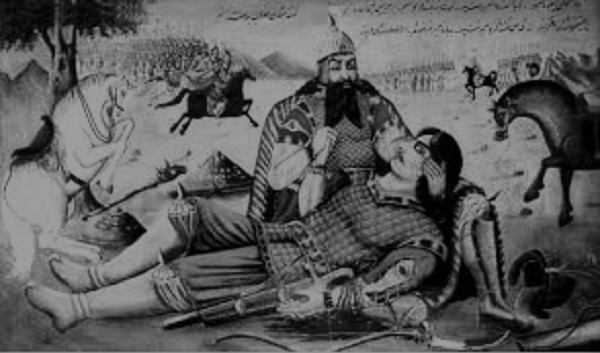
Years passed by and a war broke between the forces of Persia and Turan. By now, Sohrab had grown enough and became a hero and best warrior in the Turan army. Unaware of these developments, the father and son duo Rostam and Sohrab were found pitted against each other in the bitter war. As Rostam had already earned a name as an unmatched warrior of the Persian army, no one else dared to confront him but Sohrab came forward to restle against him. Although Sohrab knew his father’s name but Rostam had no knowledge about his adversary as he had not been in touch with Princess Tahmina after their first rendezvous. A long and heavy bout of wrestling ensued, Rostam eventually defeated Sohrab, who while dying uttered that his father Rostam would certainly avenge his death. Rostam now identified his son through his bracelet, terribly grieved but the life of Sohrab could not be saved.
5. Azhi Dahaka, the Dragon
In Persian mythology, Azhi Dahaka or a dragon is an embodiment of the evil Ahriman or Angra Mainyu. In ancient time, following his constant tussle with the Persian god Ahura Mazda, Ahriman decided to create a fearsome monster who could destroy all the goodness from the realm to enable the dark forces to dominate the world with anarchy and chaos. So he created Azhi Dahaka, the dragon, who had three frighful heads with the body of a huge serpent that eventually became a symbol of evil and terror in the Persia. The dragon vehementally spitted fire, was very powerful and was able to sense any kind of threat instantly. Thus he created hell for the life of people through his indiscriminate killings and targeting everything that was good around.
Finally, a Persian hero Fereydun could not bear with the plight of people and decided to face the evil dragon single handedly. In his ensuing battle, he did not kill the dragon because its corpse would have released numerous demons who could capture and further torment the world but he was able to tie the beast and imprisoned it in the Mount Damawand. The folklore is that the dragon is still chained inside the Mountain Damawand and will remain so until the end of the world. In another version of the mythical tale, Zahhak or Azhi Dahaka is depicted as an evil Persian king, who bore a serpent on each of his shoulders. He was a tyrant ruler who daily fed young people’s brain to his serpents. Eventually, the Persian hero Fereydun overpowered and imprisoned him in the mountain and became the king himself.
Epilogue
Like other glorious and notable ancient civilizations such as Greek, Roman and Egypt of the old world, the Persian civilization too was a great contemporary civilization. Interestingly, The Indian and Persian civilizations had many unique and common traits and legacies in their contemporary culture and religion. Though Persians had constant rivalry and war for supremacy with Greeks, Romans and Ezypt westwardly, they largely remained at peace with India through the large span of history despite being neighbours except a brief spell when the ambitious kings of the Achaemenid Empire tried to expand their empire eastward too. Years later, Hindus of the Indian sub-continent welcomed Persians (Zoroatrians) with open hands and heart when their life, property and faith was threatened at the hands of Islamists in Persia. Today, only few Parsis have survived mainly in India and some other places, but they are contributing much more to their host nation’s prosperity and well-being than their own share and size of the population.
Continued to Next Page
Images (c) istock.com
17-Apr-2021
More by : Dr. Jaipal Singh